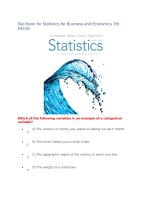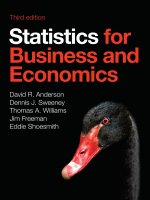Statistics for business economics 7th by paul newbold chapter 12
Bạn đang xem bản rút gọn của tài liệu. Xem và tải ngay bản đầy đủ của tài liệu tại đây (1.04 MB, 58 trang )
Statistics for
Business and Economics
7th Edition
Chapter 12
Multiple Regression
Copyright © 2010 Pearson Education, Inc. Publishing as Prentice Hall
Ch. 12-1
Chapter Goals
After completing this chapter, you should be able to:
Apply multiple regression analysis to business decisionmaking situations
Analyze and interpret the computer output for a multiple
regression model
Perform a hypothesis test for all regression coefficients
or for a subset of coefficients
Fit and interpret nonlinear regression models
Incorporate qualitative variables into the regression
model by using dummy variables
Discuss model specification and analyze residuals
Copyright © 2010 Pearson Education, Inc. Publishing as Prentice Hall
Ch. 12-2
12.1
The Multiple Regression Model
Idea: Examine the linear relationship between
1 dependent (Y) & 2 or more independent variables (X i)
Multiple Regression Model with k Independent Variables:
Y-intercept
Population slopes
Random Error
Y = β0 + β1X1 + β 2 X 2 + + βk Xk + ε
Copyright © 2010 Pearson Education, Inc. Publishing as Prentice Hall
Ch. 12-3
Multiple Regression Equation
The coefficients of the multiple regression model are
estimated using sample data
Multiple regression equation with k independent variables:
Estimated
(or predicted)
value of y
Estimated
intercept
Estimated slope coefficients
yˆ i = b0 + b1x1i + b 2 x 2i + + bk x ki
In this chapter we will always use a computer to obtain the
regression slope coefficients and other regression
summary measures.
Copyright © 2010 Pearson Education, Inc. Publishing as Prentice Hall
Ch. 12-4
Multiple Regression Equation
(continued)
Two variable model
y
pe
o
Sl
fo
i
ar
v
r
le
ab
yˆ = b0 + b1x1 + b 2 x 2
x1
x2
iable x 2
r
a
v
r
o
f
Slope
x1
Copyright © 2010 Pearson Education, Inc. Publishing as Prentice Hall
Ch. 12-5
Multiple Regression Model
Two variable model
y
yi
Sample
observation
yˆ = b0 + b1x1 + b 2 x 2
<
<
yi
ei = (yi – yi)
x2i
x1
Copyright © 2010 Pearson Education, Inc. Publishing as Prentice Hall
<
x1i
x2
The best fit equation, y ,
is found by minimizing the
sum of squared errors, Σe2
Ch. 12-6
Standard Multiple Regression
Assumptions
The values xi and the error terms εi are
independent
The error terms are random variables with mean 0
and a constant variance, σ2.
E[ε i ] = 0 and E[ε i2 ] = σ 2
for (i = 1, , n)
(The constant variance property is called
homoscedasticity)
Copyright © 2010 Pearson Education, Inc. Publishing as Prentice Hall
Ch. 12-7
Standard Multiple Regression
Assumptions
(continued)
The random error terms, εi , are not correlated
with one another, so that
E[ε iε j ] = 0
for all i ≠ j
It is not possible to find a set of numbers, c0, c1, . .
. , ck, such that
c 0 + c 1x1i + c 2 x 2i + + c K x Ki = 0
(This is the property of no linear relation for
the Xj’s)
Copyright © 2010 Pearson Education, Inc. Publishing as Prentice Hall
Ch. 12-8
Example:
2 Independent Variables
A distributor of frozen desert pies wants to
evaluate factors thought to influence demand
Dependent variable:
Pie sales (units per week)
Independent variables:
Advertising ($100’s)
Price (in $)
Data are collected for 15 weeks
Copyright © 2010 Pearson Education, Inc. Publishing as Prentice Hall
Ch. 12-9
Pie Sales Example
Week
Pie
Sales
Price
($)
Advertising
($100s)
1
350
5.50
3.3
2
460
7.50
3.3
3
350
8.00
3.0
4
430
8.00
4.5
5
350
6.80
3.0
6
380
7.50
4.0
7
430
4.50
3.0
8
470
6.40
3.7
9
450
7.00
3.5
10
490
5.00
4.0
11
340
7.20
3.5
12
300
7.90
3.2
13
440
5.90
4.0
14
450
5.00
3.5
15
300
7.00
2.7
Copyright © 2010 Pearson Education, Inc. Publishing as Prentice Hall
Multiple regression equation:
Sales = b0 + b1 (Price)
+ b2 (Advertising)
Ch. 12-10
12.2
Estimating a Multiple Linear
Regression Equation
Excel will be used to generate the coefficients and
measures of goodness of fit for multiple regression
Data / Data Analysis / Regression
Copyright © 2010 Pearson Education, Inc. Publishing as Prentice Hall
Ch. 12-11
Multiple Regression Output
Regression Statistics
Multiple R
0.72213
R Square
0.52148
Adjusted R Square
0.44172
Standard Error
47.46341
Observations
ANOVA
15
df
Regression
Sales = 306.526 - 24.975(Price) + 74.131(Adv ertising)
SS
MS
F
Significance F
2
29460.027
14730.013
Residual
12
27033.306
2252.776
Total
14
56493.333
Coefficients
Standard Error
Intercept
306.52619
114.25389
2.68285
0.01993
57.58835
555.46404
Price
-24.97509
10.83213
-2.30565
0.03979
-48.57626
-1.37392
74.13096
25.96732
2.85478
0.01449
17.55303
130.70888
Advertising
Copyright © 2010 Pearson Education, Inc. Publishing as Prentice Hall
6.53861
t Stat
0.01201
P-value
Lower 95%
Upper 95%
Ch. 12-12
The Multiple Regression Equation
Sales = 306.526 - 24.975(Pri ce) + 74.131(Adv ertising)
where
Sales is in number of pies per week
Price is in $
Advertising is in $100’s.
b1 = -24.975: sales
will decrease, on
average, by 24.975
pies per week for
each $1 increase in
selling price, net of
the effects of changes
due to advertising
Copyright © 2010 Pearson Education, Inc. Publishing as Prentice Hall
b2 = 74.131: sales will
increase, on average,
by 74.131 pies per
week for each $100
increase in
advertising, net of the
effects of changes
due to price
Ch. 12-13
12.3
Coefficient of Determination, R2
Reports the proportion of total variation in y
explained by all x variables taken together
SSR regression sum of squares
R =
=
SST
total sum of squares
2
This is the ratio of the explained variability to total
sample variability
Copyright © 2010 Pearson Education, Inc. Publishing as Prentice Hall
Ch. 12-14
Coefficient of Determination, R2
(continued)
Regression Statistics
Multiple R
0.72213
R Square
0.52148
Adjusted R Square
0.44172
Standard Error
15
df
Regression
52.1% of the variation in pie sales
is explained by the variation in
price and advertising
47.46341
Observations
ANOVA
SSR 29460.0
R =
=
= .52148
SST 56493.3
2
SS
MS
F
Significance F
2
29460.027
14730.013
Residual
12
27033.306
2252.776
Total
14
56493.333
Coefficients
Standard Error
Intercept
306.52619
114.25389
2.68285
0.01993
57.58835
555.46404
Price
-24.97509
10.83213
-2.30565
0.03979
-48.57626
-1.37392
74.13096
25.96732
2.85478
0.01449
17.55303
130.70888
Advertising
Copyright © 2010 Pearson Education, Inc. Publishing as Prentice Hall
6.53861
t Stat
0.01201
P-value
Lower 95%
Upper 95%
Ch. 12-15
Estimation of Error Variance
Consider the population regression model
Yi = β0 + β1x1i + β 2 x 2i + + βK x Ki + ε i
The unbiased estimate of the variance of the errors is
n
s 2e =
2
e
∑ i
SSE
n − K −1 n − K −1
i =1
=
where ei = y i − yˆ i
The square root of the variance, se , is called the
standard error of the estimate
Copyright © 2010 Pearson Education, Inc. Publishing as Prentice Hall
Ch. 12-16
Standard Error, se
Regression Statistics
Multiple R
0.72213
R Square
0.52148
Adjusted R Square
0.44172
Standard Error
15
df
Regression
The magnitude of this
value can be compared to
the average y value
47.46341
Observations
ANOVA
se = 47.463
SS
MS
F
Significance F
2
29460.027
14730.013
Residual
12
27033.306
2252.776
Total
14
56493.333
Coefficients
Standard Error
Intercept
306.52619
114.25389
2.68285
0.01993
57.58835
555.46404
Price
-24.97509
10.83213
-2.30565
0.03979
-48.57626
-1.37392
74.13096
25.96732
2.85478
0.01449
17.55303
130.70888
Advertising
Copyright © 2010 Pearson Education, Inc. Publishing as Prentice Hall
6.53861
t Stat
0.01201
P-value
Lower 95%
Upper 95%
Ch. 12-17
Adjusted Coefficient of
Determination, R 2
R2 never decreases when a new X variable is
added to the model, even if the new variable is not
an important predictor variable
This can be a disadvantage when comparing
models
What is the net effect of adding a new variable?
We lose a degree of freedom when a new X
variable is added
Did the new X variable add enough
explanatory power to offset the loss of one
degree of freedom?
Copyright © 2010 Pearson Education, Inc. Publishing as Prentice Hall
Ch. 12-18
Adjusted Coefficient of
2
Determination, R
(continued)
Used to correct for the fact that adding non-relevant
independent variables will still reduce the error sum of
squares
SSE / (n − K − 1)
2
R = 1−
SST / (n − 1)
(where n = sample size, K = number of independent variables)
Adjusted R2 provides a better comparison between multiple regression models with different numbers of independent variables
Penalize excessive use of unimportant independent variables
Smaller than R2
Copyright © 2010 Pearson Education, Inc. Publishing as Prentice Hall
Ch. 12-19
R
Regression Statistics
Multiple R
0.72213
R Square
0.52148
Adjusted R Square
0.44172
Standard Error
47.46341
Observations
ANOVA
15
df
Regression
2
R = .44172
2
44.2% of the variation in pie sales is
explained by the variation in price and
advertising, taking into account the sample
size and number of independent variables
SS
MS
F
Significance F
2
29460.027
14730.013
Residual
12
27033.306
2252.776
Total
14
56493.333
Coefficients
Standard Error
Intercept
306.52619
114.25389
2.68285
0.01993
57.58835
555.46404
Price
-24.97509
10.83213
-2.30565
0.03979
-48.57626
-1.37392
74.13096
25.96732
2.85478
0.01449
17.55303
130.70888
Advertising
Copyright © 2010 Pearson Education, Inc. Publishing as Prentice Hall
6.53861
t Stat
0.01201
P-value
Lower 95%
Upper 95%
Ch. 12-20
Coefficient of Multiple
Correlation
The coefficient of multiple correlation is the correlation
between the predicted value and the observed value of
the dependent variable
R = r(yˆ , y) = R 2
Is the square root of the multiple coefficient of
determination
Used as another measure of the strength of the linear
relationship between the dependent variable and the
independent variables
Comparable to the correlation between Y and X in
simple regression
Copyright © 2010 Pearson Education, Inc. Publishing as Prentice Hall
Ch. 12-21
Evaluating Individual
Regression Coefficients
12.4
Use t-tests for individual coefficients
Shows if a specific independent variable is
conditionally important
Hypotheses:
H0: βj = 0 (no linear relationship)
H1: βj ≠ 0 (linear relationship does exist
between xj and y)
Copyright © 2010 Pearson Education, Inc. Publishing as Prentice Hall
Ch. 12-22
Evaluating Individual
Regression Coefficients
(continued)
H0: βj = 0 (no linear relationship)
H1: βj ≠ 0 (linear relationship does exist
between xi and y)
Test Statistic:
t=
bj − 0
Sb j
Copyright © 2010 Pearson Education, Inc. Publishing as Prentice Hall
(df = n – k – 1)
Ch. 12-23
Evaluating Individual
Regression Coefficients
(continued)
Regression Statistics
Multiple R
0.72213
R Square
0.52148
Adjusted R Square
0.44172
Standard Error
47.46341
Observations
ANOVA
15
df
Regression
t-value for Price is t = -2.306, with
p-value .0398
t-value for Advertising is t = 2.855,
with p-value .0145
SS
MS
F
Significance F
2
29460.027
14730.013
Residual
12
27033.306
2252.776
Total
14
56493.333
Coefficients
Standard Error
Intercept
306.52619
114.25389
2.68285
0.01993
57.58835
555.46404
Price
-24.97509
10.83213
-2.30565
0.03979
-48.57626
-1.37392
74.13096
25.96732
2.85478
0.01449
17.55303
130.70888
Advertising
Copyright © 2010 Pearson Education, Inc. Publishing as Prentice Hall
6.53861
t Stat
0.01201
P-value
Lower 95%
Upper 95%
Ch. 12-24
Example: Evaluating Individual
Regression Coefficients
From Excel output:
H0: βj = 0
H1: βj ≠ 0
Coefficients
Standard Error
-24.97509
74.13096
Price
Advertising
d.f. = 15-2-1 = 12
t Stat
P-value
10.83213
-2.30565
0.03979
25.96732
2.85478
0.01449
The test statistic for each variable falls
in the rejection region (p-values < .05)
α = .05
t12, .025 = 2.1788
Decision:
α/2=.025
Reject H0 for each variable
α/2=.025
Conclusion:
Reject H0
Do not reject H0
-tα/2
-2.1788
0
Reject H0
tα/2
2.1788
Copyright © 2010 Pearson Education, Inc. Publishing as Prentice Hall
There is evidence that both
Price and Advertising affect
pie sales at α = .05
Ch. 12-25









